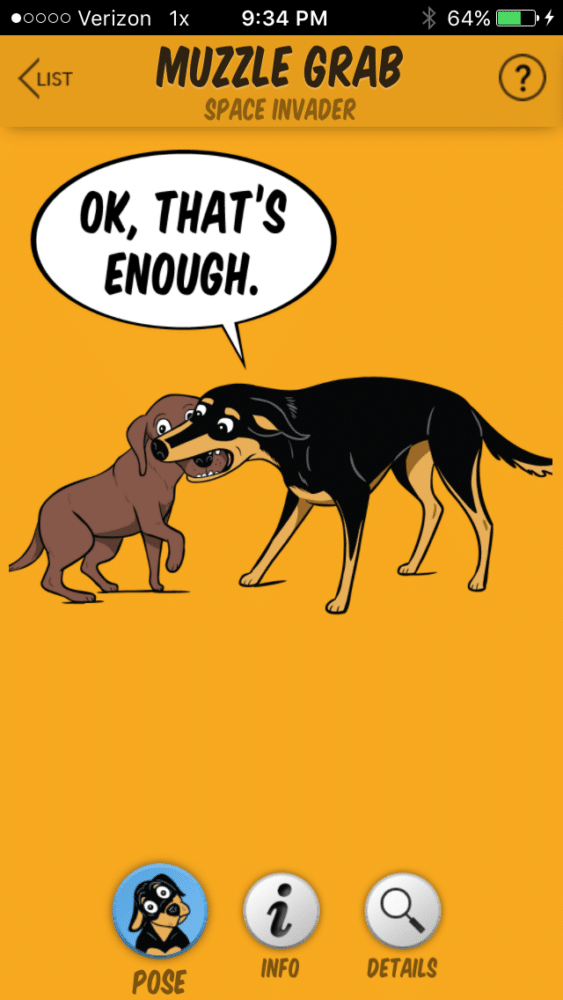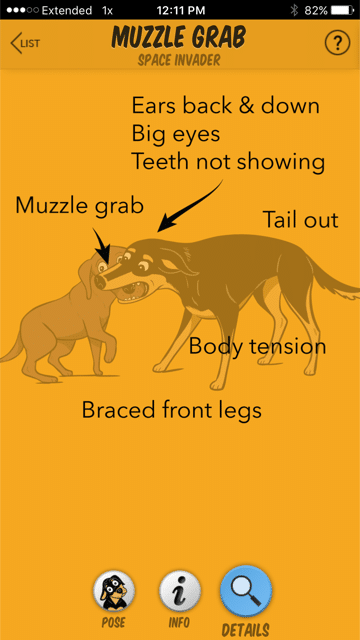Dogs are impressive teachers, regularly educating each other on how they like to play and interact. This is why proper socialization at critical periods in a puppy’s life helps them to become a well-adjusted adult dog. “Proper” is the keyword here, and I caution everyone to do their due diligence before joining a puppy socialization class, as some facilities are not well-versed in dog body language, and do not know when an intervention is appropriate and when to let dogs teach each other. (The Dog Gurus do a wonderful job of teaching dog daycare employees how to properly supervise play groups.)
Dogs for the most part are non-confrontational, and when they do need to tell a puppy that they are uncomfortable, they often do so with a non-violent communication such as a muzzle grab.
Take a look at these images from my Dog Decoder smartphone app about dog body language. They show a typical scenario of an adult dog teaching a puppy. A muzzle grab is not aggressive, nor is it a bite; it’s a hold that is not meant to puncture or cause pain, but to simply let the puppy know they have gone too far.

The muzzle grab. (Image from the Dog Decoder smartphone app/illustration by Lili Chin)
Now take a look at all of the adult dog’s body language cues.

The muzzle grab in context. (Image from the Dog Decoder smartphone app/illustration by Lili Chin)
Diamond, the star of Dog Decoder, is putting his mouth over the puppy’s muzzle, holding firmly yet gently, saying that he’s reached his limits. Pups will be pups, and when they are learning social etiquette in dog groups, some are pushier than others and need to be told that their behavior is unwanted.
A muzzle grab is used mostly as a last resort. By the time a teacher dog needs to use it, they’ve already looked away, taken a defensive stance, stiffened their body and tail, and perhaps even growled. If puppy doesn’t take these cues seriously, the teacher dog uses a muzzle grab to say “I’m done playing.” This is perfectly acceptable and warranted, and we should not intervene. Usually, this doesn’t need to happen more than once for the puppy to understand and back off.
My dog Rascal teaching adolescent Golden Retriever Sadie that he’s had enough. (Image by Jill Breitner)
One last point: While dog body language teaches us much about how they communicate with each, we should not behave like a dog ourself. We shouldn’t grab a dog’s muzzle when they’re doing something we don’t like, such as playfully biting or chewing on something. We are not dogs, and dogs don’t see us as such, therefore behaving like one will confuse them and could back fire with a bite. A muzzle grab for dog to dog communication only. If we are teaching a dog not to act a certain way, we must teach the behavior we do want in order to be effective and humane in our teaching approach.
About the author: Jill Breitner is a professional dog trainer and dog body language expert. She is a certified Fear Free Professional, Fear Free Professional for Foundation for Puppies and Kittens, as well as Certified in Animal Behavior and Welfare. She is the author of the Dog Decoder, a smartphone app about dog body language. Join Jill on her on her Facebook page.
The post What Does It Mean When an Adult Dog Grabs a Puppy by the Muzzle? appeared first on Dogster.
No comments:
Post a Comment